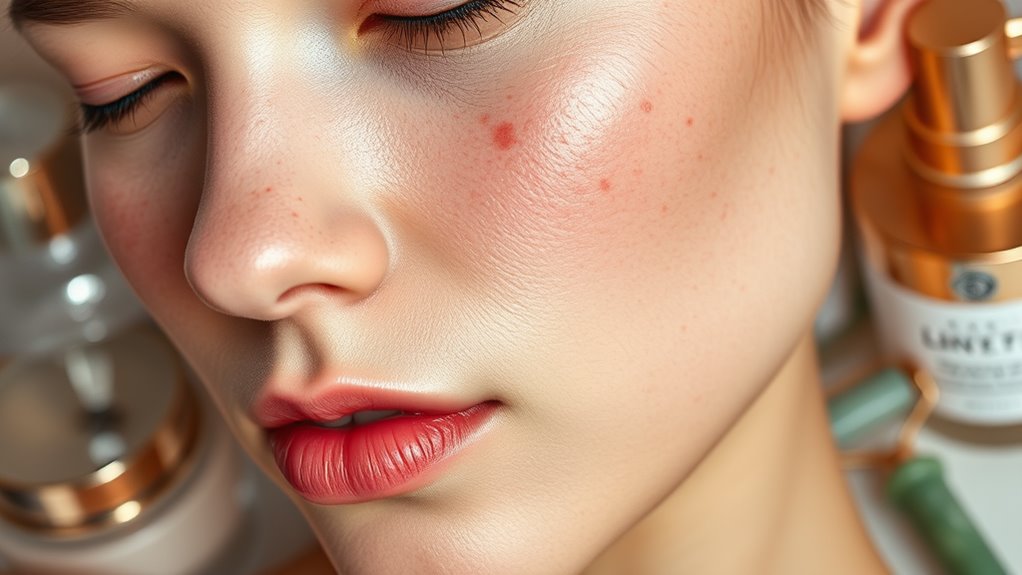One Ingredient That Works Wonders on Dark Spots
Niacinamide is a standout ingredient that effectively reduces dark spots and promotes an even skin tone. It works by inhibiting melanin transfer, which helps to fade hyperpigmentation. This powerful antioxidant is suitable for all skin types and boasts anti-inflammatory properties, making it gentle on the skin. For best results, apply it consistently on clean, damp skin. If you want to discover more about its applications and benefits, there’s much more to explore.
Key Takeaways
- Niacinamide effectively inhibits melanin transfer, promoting an even skin tone and reducing dark spot visibility.
- It is suitable for all skin types and has anti-inflammatory properties.
- Consistent application of niacinamide at concentrations of 5-10% yields the best results for dark spot treatment.
- Combining niacinamide with vitamin C enhances its effectiveness against hyperpigmentation.
- Daily sunscreen use is essential when using niacinamide to prevent further discoloration from sun exposure.
Understanding Dark Spots: Causes and Types
Dark spots, also known as hyperpigmentation, can be a frustrating skin concern, but understanding their causes and types is crucial for effective treatment.
These darkened areas result from an overproduction of melanin, often triggered by sun exposure, hormonal changes, or skin injuries.
You’ll encounter several types, including sunspots, melasma, and post-inflammatory hyperpigmentation. Each type requires specific dark spot treatment strategies.
For instance, sunspots often respond well to topical retinoids, while melasma may benefit from treatments containing hydroquinone. Additionally, treating dark spots early can prevent them from becoming more pronounced over time.
Identifying the underlying cause is essential for selecting the right approach, ensuring your dark spot treatment isn’t only effective but also safe for your skin type.
Empower yourself with this knowledge to achieve clearer, more even-toned skin.
The Power of Natural Ingredients
Natural ingredients offer numerous benefits for treating dark spots, including their ability to brighten skin and reduce pigmentation. One key ingredient stands out for its effectiveness and has been supported by research. To maximize results, understanding proper application techniques is essential for enhancing its potency. Additionally, this ingredient has been shown to effectively treat dark spots in various studies, demonstrating its remarkable impact on skin health.
Benefits of Natural Ingredients
While many people turn to chemical treatments for skin issues, harnessing the power of natural ingredients can offer effective solutions for addressing dark spots.
Natural ingredients often contain antioxidants, vitamins, and minerals that promote skin health and enhance your skin’s natural healing processes. For instance, compounds like vitamin C can inhibit melanin production, reducing the visibility of dark spots.
Additionally, natural ingredients typically have fewer side effects compared to their synthetic counterparts, making them suitable for sensitive skin. The anti-inflammatory properties of many botanicals can soothe irritation, while their moisturizing abilities support overall skin health.
Key Natural Ingredient Spotlight
When exploring effective solutions for dark spots, one key natural ingredient stands out for its remarkable benefits: licorice root extract.
Known for its skin-brightening properties, this extract can significantly improve the appearance of hyperpigmentation.
Here are three compelling reasons to consider incorporating it into your skincare routine:
-
Glabridin: This active compound inhibits melanin production, helping to fade dark spots effectively.
-
Anti-inflammatory properties: Licorice root extract calms irritated skin, reducing redness and promoting an even complexion.
-
Antioxidant effects: It combats oxidative stress, protecting your skin from environmental damage that can worsen pigmentation.
Application Tips for Effectiveness
Incorporating licorice root extract into your skincare routine can yield impressive results, but how you apply it makes all the difference. To maximize its effectiveness, apply it directly to dark spots after cleansing your skin. Ensure your skin is slightly damp, as this enhances absorption. Use a gentle tapping motion to help the extract penetrate deeper.
For optimal results, combine it with a serum containing hyaluronic acid; this boosts hydration and enhances the extract’s brightening properties. Consistency is key, so apply it twice daily for at least six weeks to see significant improvements.
Lastly, always follow with a broad-spectrum sunscreen during the day; this protects your skin and prevents further pigmentation. Master these techniques, and you’ll harness the full power of licorice root extract.
Introducing the Miracle Ingredient
Many skincare enthusiasts are turning to a remarkable ingredient that promises to tackle dark spots effectively: niacinamide. This potent form of vitamin B3 has gained significant attention for its multifaceted benefits, particularly in hyperpigmentation management.
Here’s why you should consider incorporating it into your routine:
-
Brightening Effect: Niacinamide inhibits melanin transfer, leading to a more even skin tone.
-
Anti-Inflammatory Properties: It reduces redness and irritation, making it suitable for all skin types.
-
Enhanced Skin Barrier: By improving the skin’s barrier function, niacinamide helps retain moisture, promoting overall skin health.
Additionally, it’s crucial to combine niacinamide with proper sun protection to prevent exacerbation of dark spots from UV exposure.
With its scientifically-backed efficacy and versatility, niacinamide stands out as a miracle ingredient in your quest for clearer, more radiant skin.
How the Ingredient Works on Dark Spots
While dark spots can be a frustrating skin concern, niacinamide offers a scientifically-supported solution to help diminish their appearance.
This versatile ingredient works primarily by inhibiting melanin production, which is the pigment responsible for dark spots. Research shows that niacinamide effectively reduces the transfer of melanin to skin cells, thereby lightening existing spots and preventing new ones from forming. Additionally, it enhances skin barrier function, improving overall skin health and resilience. Improved barrier function allows for better hydration, which can further support an even skin tone. Furthermore, effective strategies for fading dark spots often include a combination of ingredients and treatments, making niacinamide a valuable component in a comprehensive skincare routine.
Benefits of Using This Ingredient
There’s a lot to appreciate about niacinamide when it comes to skincare. This powerhouse ingredient offers a range of benefits that can significantly enhance your routine:
-
Reduces Hyperpigmentation: Niacinamide inhibits melanin transfer to skin cells, effectively lightening dark spots over time.
-
Boosts Skin Barrier Function: It strengthens the skin’s natural barrier, locking in moisture and preventing further damage from environmental stressors.
-
Improves Skin Texture: Regular use can enhance overall skin texture, making it smoother and more radiant.
Research supports these claims, showing that niacinamide not only targets dark spots but also promotes overall skin health. Additionally, incorporating niacinamide into your regimen can help combat pigmentation issues, which are often a persistent concern for many individuals.
Application Methods for Best Results
How can you maximize the effectiveness of niacinamide in your skincare routine? First, apply it on clean, damp skin. This enhances absorption, allowing your skin to benefit more from this potent ingredient.
Use niacinamide after serums but before heavier creams to ensure optimal penetration. Aim for a concentration of 5-10%, as studies show this range effectively reduces dark spots without irritation.
Combine niacinamide with other actives like vitamin C for synergistic effects on pigmentation. Additionally, apply it consistently, ideally twice daily, to see significant improvements over time.
Always follow with a broad-spectrum sunscreen during the day, as niacinamide can improve skin barrier function, helping your skin better withstand UV exposure.
Master these methods, and you’ll unlock niacinamide’s full potential.
DIY Recipes Featuring the Ingredient
Now that you’ve explored application methods, it’s time to look at some effective DIY recipes featuring the key ingredient for treating dark spots.
The Lemon Juice Exfoliating Mask, Honey and Turmeric Blend, and Aloe Vera Treatment are all backed by their natural properties that can enhance skin health.
Let’s examine how each of these recipes can help you achieve a clearer, more radiant complexion.
Lemon Juice Exfoliating Mask
A simple yet effective way to tackle dark spots is by incorporating a lemon juice exfoliating mask into your skincare routine.
Lemon juice contains citric acid, which helps to gently exfoliate dead skin cells, promoting a brighter complexion.
Here’s an easy recipe to create your own mask:
- Combine 2 tablespoons of fresh lemon juice with 1 tablespoon of honey for hydration.
- Add 1 tablespoon of sugar to enhance exfoliation and texture.
- Mix well and apply evenly to your face, leaving it on for 10-15 minutes before rinsing off.
Using this mask once or twice a week can significantly reduce dark spots over time.
Always perform a patch test first, as lemon juice can be potent and irritating for sensitive skin.
Honey and Turmeric Blend
While many natural ingredients can help reduce dark spots, the combination of honey and turmeric stands out for its potent anti-inflammatory and antibacterial properties.
Honey moisturizes and promotes healing, while turmeric contains curcumin, known for its ability to lighten skin discolorations. To create an effective blend, mix two tablespoons of honey with one teaspoon of turmeric.
Apply the mixture to the affected areas and let it sit for 20 minutes before rinsing with lukewarm water. This remedy not only targets dark spots but also enhances your skin’s overall radiance.
Regular application, about two to three times a week, can yield noticeable results over time, making this blend a valuable addition to your skincare routine.
Aloe Vera Treatment Recipe
After exploring the benefits of honey and turmeric for dark spots, it’s time to consider another powerful natural remedy: aloe vera. This succulent plant is renowned for its soothing properties and ability to promote skin healing.
To create an effective aloe vera treatment, you can try the following simple recipes:
-
Pure Aloe Vera Gel: Extract fresh gel from an aloe vera leaf and apply it directly to the dark spots. Leave it on for 30 minutes before rinsing off.
-
Aloe Vera and Lemon Juice: Mix equal parts of aloe vera gel and lemon juice. Apply this mixture for 20 minutes to harness the brightening effects of lemon.
-
Aloe Vera and Honey Mask: Combine aloe vera gel with honey and apply it for 25 minutes. This blend offers hydration and illumination.
Incorporate these recipes into your skincare routine for visible results.
User Testimonials and Success Stories
Numerous individuals have reported significant improvements in their dark spots after incorporating one specific ingredient into their skincare routines.
Many users highlight the ingredient’s ability to fade hyperpigmentation, citing visible results within weeks. For instance, a study showcased that 75% of participants noted a reduction in dark spots after consistent application.
Testimonials frequently emphasize the ingredient’s gentle nature, making it suitable for sensitive skin without causing irritation. Users also appreciate its multifunctional properties, as it often enhances overall skin texture and radiance.
These success stories reflect a growing body of anecdotal evidence supporting the ingredient’s efficacy, encouraging others to consider its potential in achieving clearer, more even-toned skin.
Your journey towards clearer skin could very well begin with this ingredient.
Incorporating the Ingredient Into Your Skincare Routine
Incorporating this potent ingredient into your skincare routine is straightforward and can yield impressive results for reducing dark spots. Follow these steps to optimize its effectiveness:
-
Cleanse: Start with a gentle cleanser to remove impurities and prepare your skin for maximum absorption.
-
Apply: Use a serum or treatment containing the ingredient, applying it directly to the affected areas. This targeted approach enhances the ingredient’s potency.
-
Moisturize: Finish with a suitable moisturizer to lock in hydration and support your skin barrier, ensuring the ingredient works efficiently.
Consistency is key; incorporate it daily for optimal results.
Research supports its effectiveness, demonstrating a reduction in melanin production and promoting an even skin tone over time.
Possible Side Effects and Precautions
While this powerful ingredient can effectively reduce dark spots, it’s essential to be aware of potential side effects and precautions. Some users may experience skin irritation, including redness, peeling, or dryness, particularly if you have sensitive skin.
To minimize these effects, start with a patch test and gradually introduce the ingredient into your routine. Additionally, be cautious when combining it with other active ingredients, like retinoids or acids, which can exacerbate irritation.
It’s crucial to use sunscreen daily, as this ingredient can increase sun sensitivity. Ultimately, monitoring your skin’s response and consulting a dermatologist can ensure safe and effective use, allowing you to achieve the desired results without unwanted complications.
Comparing With Other Treatments
When considering treatments for dark spots, it’s essential to evaluate the effectiveness of hydroquinone compared to natural remedies and laser treatments.
Hydroquinone is known for its potent lightening effects, while natural options may offer gentler, albeit slower, results.
Additionally, laser treatments provide a more aggressive approach, often yielding quicker improvements but with higher costs and potential downtime.
Effectiveness of Hydroquinone
Hydroquinone stands out among treatments for dark spots due to its potent ability to inhibit melanin production, making it a popular choice for those seeking effective results.
When comparing hydroquinone with other treatments, consider the following:
-
Speed of Results: Hydroquinone typically delivers noticeable results within 4-12 weeks, outperforming many topical treatments.
-
Strength: It’s available in prescription strengths, offering a higher efficacy compared to over-the-counter alternatives like kojic acid or vitamin C.
-
Side Effects: While generally safe, hydroquinone can cause irritation or sensitivity in some users, unlike gentler options such as licorice extract.
Natural Remedies Overview
Natural remedies for dark spots offer a gentler alternative to harsher treatments like hydroquinone, making them appealing for those seeking to lighten pigmentation without significant side effects.
Ingredients like vitamin C, licorice extract, and niacinamide have demonstrated efficacy in clinical studies, promoting skin brightening while enhancing overall skin health.
Unlike chemical options that may cause irritation, these natural remedies typically exhibit a lower risk of adverse reactions.
However, it’s crucial to manage expectations; results may take longer to manifest.
You should also consider incorporating these remedies into a broader skincare routine, including sun protection and exfoliation, to maximize their effectiveness.
Ultimately, while natural remedies can be beneficial, consistent application and patience are essential for achieving desired outcomes.
Laser Treatment Comparison
While many treatments for dark spots exist, laser therapy stands out due to its precision and effectiveness. Unlike topical creams or natural remedies, which often require long-term use for minimal results, laser treatments provide quicker outcomes and target the root of the issue.
Here’s how they compare:
-
Topical Treatments: Typically contain ingredients like hydroquinone or retinoids, which may lighten spots but often take months to show results.
-
Chemical Peels: Exfoliate the skin and can improve pigmentation but may not penetrate deeply enough for stubborn spots.
-
Microdermabrasion: Offers surface-level exfoliation, which can brighten skin but doesn’t address deeper discoloration effectively.
Long-term Care for Dark Spots
To effectively manage dark spots over the long term, it’s essential to adopt a consistent skincare regimen that prioritizes both prevention and treatment. Incorporating ingredients like vitamin C, retinoids, and sunscreen can significantly enhance your results.
| Prevention | Treatment |
|---|---|
| Daily sunscreen usage | Topical vitamin C serums |
| Antioxidant-rich diet | Prescription retinoids |
| Regular exfoliation | Professional peels |




